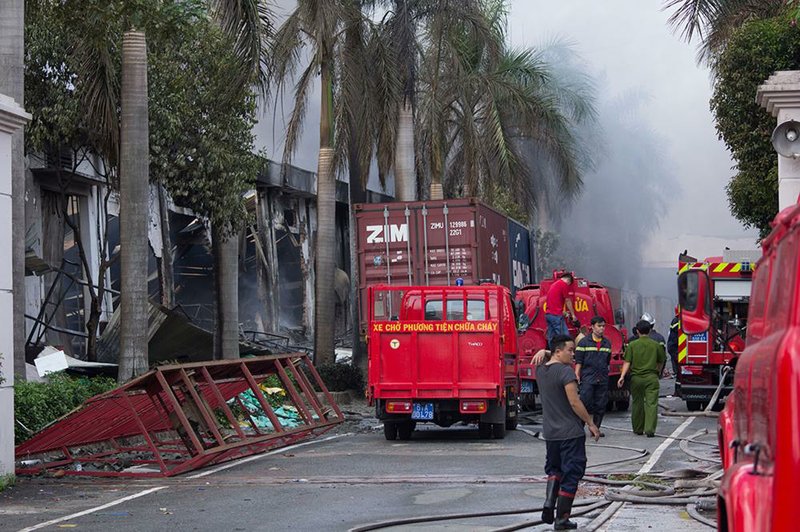HANOI, Vietnam — A 1,000-strong mob stormed a Taiwanese steel mill in Vietnam, killing at least one Chinese worker and injuring 90 more, the Taiwanese ambassador said today, making it the first deadly episode in a wave of anti-Chinese riots and protests prompted by Beijing’s deployment of an oil rig in disputed seas.
The unrest took place at a mill in Ha Tinh province in central Vietnam, 155 miles south of Hanoi, operated by the conglomerate Formosa Plastics Group, one of the biggest foreign investors in Vietnam, according to Ambassador Huang Chih-peng and local hospital officials.
Huang, who spoke to a member of the management team at the mill this morning, said rioters lit fires at several buildings and hunted down the Chinese workers.
A hospital official doctor at the Ha Tinh General Hospital said some 50 people, most of them Chinese were admitted to the hospital Wednesday night and early today. He didn’t give his name because he was not authorized to speak to the media.
More than 400 people were arrested after riots in which scores of foreign-owned factories were damaged or destroyed in an industrial area in southern Vietnam, authorities said Wednesday.
The riots, which were the worst in recent Vietnamese history, reportedly began Tuesday night as protests against China’s stationing of an oil rig in disputed waters off Vietnam’s coast. But violence spiraled, and the vast majority of factories damaged were owned by companies from Taiwan and South Korea, not from mainland China.
“There was quite a lot of damage,” said Chen Borshow, the director general for the Taipei Economic and Cultural Office in Ho Chi Minh City. Chen said about 200 companies were affected.
YTN, a South Korean news channel, reported that about 50 Korean companies were attacked by mobs. Five factory personnel were slightly injured, and one was hospitalized with a leg injury, the channel reported.
About 19,000 workers were involved in the protests Tuesday, said Tran Van Nam, the vice chairman of Binh Duong province, where the violence occurred. He was quoted by VNExpress, a Vietnamese online news site.
Another provincial official, Tran Xuan Nam, said late Wednesday that the situation there was “stable” and that 447 suspects had been detained. Tran Xuan Nam said 20 factories had been “seriously destroyed.” He attributed the riots to “extremism,” but did not elaborate.
The Chinese Embassy in Hanoi issued a notice Wednesday that urged Chinese people living in Vietnam to “minimize unnecessary outings.”
A staff member at the Chutex Garment Factory north of Ho Chi Minh City said 8,000 to 10,000 workers were involved in the rampage at his factory.
“They burned the office,” said the staff member, who agreed to speak on the condition that his name not be used. The rioters “burned everything, all of the materials, computers, machines.”
The Chutex factory, in Song Than Industrial Park 2 in Binh Duong, is described on its website as one of the largest garment exporters in Vietnam. Chutex International, the parent company, was founded by a garment executive from Taiwan. It is unclear why rioters targeted a factory linked to Taiwan. News outlets in Hong Kong said workers might not have been distinguishing between mainland China and Taiwan, a self-governing island which also has claims to territory in the South China Sea.
Taiwan’s Foreign Ministry condemned the rioting. In a statement, it called on the demonstrators to “exercise self-control, don’t behave irrationally, damage Taiwanese factory equipment or threaten the safety of Taiwanese businesspeople, which could harm Taiwan’s willingness to invest and harm the longstanding friendly relations between the people of Taiwan and Vietnam.”
The Chinese oil rig that sparked the protests is 140 miles off the coast of Vietnam and about 17 miles from a small island claimed by both countries. Vietnamese and Chinese vessels have collided a number of times near the rig.
Earlier this week, U.S. Secretary of State John Kerry reportedly told his Chinese counterpart, Foreign Minister Wang Yi, that the “introduction of an oil rig and numerous government vessels in waters disputed with Vietnam was provocative,” a U.S. State Department representative said.
But China’s state-run news agency, Xinhua, disputed the State Department’s account of Kerry’s conversation Tuesday.
“In fact, U.S. Secretary of State Kerry made no such comments during the phone conversation,” a Chinese Foreign Ministry spokesman, Hua Chunying, was quoted as saying. She said Kerry did not use the word “provocative.”
Kerry’s message, Xinhua said, was that the United States was not taking sides in the dispute.
Information for this article was contributed by Chau Doan,Thomas Fuller, Keith Bradsher, Choe Sang-hun, Austin Ramzy, Mike Ives and Bree Feng of The New York Times; and by Chris Brummit of The Associated Press.
A Section on 05/15/2014

